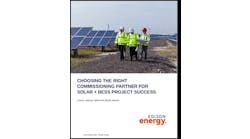Schneider Electric and Engie have completed the first phase of installing assets for Southeast Asia’s largest hybrid microgrid, a project in Singapore.
Located on Semakau Island, the microgrid is meant to serve as a model for parts of the developing world that lack reliable electricity.
The project will provide electricity for cooking and energy for green transportation, including a hydrogen system for storage and fueling a hydrogen car – a first in Singapore. Hydrogen also increases the flexibility of the microgrid because the fuel can be stored easily and used for various purposes, such as electricity production, storage, gas, and transportation.
In addition to the hydrogen technology, the project will test and demonstrate smart inverters and microgrid management. Called the ‘Sustainable Powering of Off-Grid Regions’ (SPORE), the hybrid microgrid also includes Singapore’s tallest wind turbine, solar panels and battery storage.
“This first phase of the power generation asset installation of the SPORE microgrid on Semakau Island is a significant step towards the full operation of the first multifluid, decentralized microgrid demonstration in the tropics,” said Etienne Drouet, director, ENGIE Lab Singapore.
The microgrid is part of the existing REIDS (Renewable Energy Integration Demonstrator in Singapore) initiative led by the Energy Research Institute at the Nanyang Technological University (NTU) and in collaboration with EDB (Singapore Economic Development Board) and NEA (National Environment Agency).
The project is one of several new microgrids worldwide designed to bring electrification to parts of the world with either an unreliable grid or none at all. The World Energy Outlook (WEO) estimated that 1.2 billion people, 16 percent of the global population, did not have access to electricity last year, with 95 percent living in countries within sub- Saharan Africa and developing Asia.
“In this context of global energy transition, global energy leader Schneider Electric and Engie have joined forces on Semakau Island to develop a common solution and showcase their capability of addressing the regional energy challenges,” said Jean Wild, microgrid program manager, Schneider Electric.
As described by the project partners, the key technologies within the hybrid microgrid are:
- Hydrogen technology: This includes a hydrogen electrolyser, storage and a fuel cell for conversion into electricity, and a hydrogen vehicle and refueling station.
- Smart inverters: Schneider Electric’s smart inverters act as virtual synchronous generators to address grid stability for an off-grid, all-renewable microgrid. The smart inverters couple renewable energy with power or energy storage devices to model the behavior of a genset. This result is a scalable, plug-and-play solution which ensures better grid stability at higher renewable penetration. The system also has the ability to parallel with other smart inverters or normal gensets in a microgrid.
- Microgrid management system: The SPORE microgrid management system includes Power Management System (PMS) for short-term and Energy Management System (EMS) for mid-term grid management. The PMS ensures the stability of the grid in real time by balancing production, storage and consumption. This solution maximizes the renewable penetration and ensures an efficient control of an off-grid network. The EMS works on a mid-term or monthly basis to forecast energy demand and production and provide reliable and affordable access to energy. It also manages intermittent renewable energy production.
Track news about hybrid microgrids. Follow Microgrid Knowledge on Twitter @MicrogridNews.






